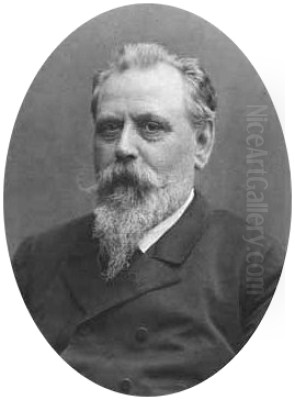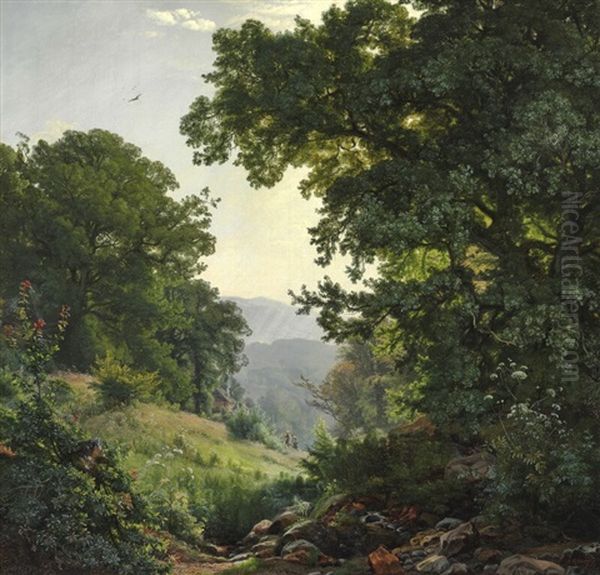
Carl Frederik Peder Aagaard stands as a significant figure in the landscape of Danish art, particularly noted for his contributions during the latter part of the nation's celebrated Golden Age. A skilled painter and decorative artist, Aagaard dedicated his career to capturing the serene beauty of nature, both in his native Denmark and across the European continent. His life, spanning from January 29, 1833, to November 2, 1895, witnessed a period of profound cultural development in Denmark, and his work reflects the artistic sensibilities of his time.
Born in Odense, Denmark, Aagaard's artistic journey began with foundational training in Aarhus. His ambition soon led him to the vibrant artistic hub of Copenhagen in 1852, seeking more advanced instruction. This move proved pivotal, allowing him access to the prestigious Royal Danish Academy of Fine Arts, the crucible where many of Denmark's greatest artistic talents were forged.
Formative Years and Artistic Training
At the Royal Danish Academy, Aagaard benefited from the tutelage of influential figures. He initially studied decorative painting under Georg Hilker, a respected artist in the field. This early training equipped Aagaard with skills that he would later apply to significant public commissions, demonstrating a versatility that extended beyond easel painting.
However, perhaps the most defining influence on Aagaard's trajectory was his mentorship under Peter Kristian Skovgaard, commonly known as P.C. Skovgaard. Skovgaard was a preeminent landscape painter of the Danish Golden Age, celebrated for his evocative depictions of Danish nature. Under Skovgaard's guidance, Aagaard honed his skills and increasingly focused his artistic energies on landscape painting, the genre for which he would become best known. This shift marked a crucial step in developing his own artistic voice.
A Nation in Transition: The Danish Golden Age
Aagaard's career unfolded against the backdrop of the Danish Golden Age, a remarkable period of cultural and artistic flourishing that occurred roughly between 1800 and 1860. This era emerged paradoxically from a time of national hardship. Denmark had suffered significant setbacks, including devastating naval defeats by the British, the bombardment of Copenhagen, state bankruptcy, and the painful loss of Norway.

These crises, however, seemed to galvanize a sense of national identity and spurred an intense focus on Danish culture, history, and landscape. Art became a vital means of expressing and exploring this burgeoning national consciousness. Figures like the painter Christoffer Wilhelm Eckersberg, often hailed as the father of Golden Age painting for his emphasis on realistic observation, and his brilliant students, such as Christen Købke, laid the groundwork. The internationally acclaimed neoclassical sculptor Bertel Thorvaldsen also brought immense prestige to Danish art during this time. Aagaard entered the scene as this initial wave was cresting, contributing to its later, mature phase.
Developing a Signature Style
Carl Aagaard's artistic style is firmly rooted in landscape painting. His work characteristically blends a commitment to realistic depiction, likely absorbed from the Academy's emphasis on observation and potentially influenced by Skovgaard's own approach, with a distinct romantic sensibility. He sought not just to record the topography of a scene, but also to capture its mood, tranquility, and the subtle interplay of light and atmosphere.
His paintings often evoke a sense of peace and harmony found in nature. Whether depicting the familiar Danish countryside or the sun-drenched vistas of Italy, Aagaard demonstrated a keen eye for detail and a masterful ability to render the effects of light, contributing to the overall emotional resonance of his work. This focus aligned well with the Golden Age ethos of finding profound beauty and national spirit within the landscape. The influence of his teacher, P.C. Skovgaard, remained evident in his dedication to the Danish landscape tradition.
Journeys Abroad: Broadening Horizons
While deeply connected to Danish scenery, Aagaard's artistic vision was significantly broadened by his travels abroad. Italy, in particular, held a strong allure for him, as it did for many Northern European artists seeking classical inspiration and picturesque landscapes. He made multiple trips south, capturing the distinct beauty of regions that were popular destinations for artists and tourists alike.
His canvases came to feature iconic locations such as the stunning Lake Como, the historic city of Naples, the idyllic island of Capri, and the dramatic coastline of Amalfi. These Italian scenes allowed him to explore different qualities of light and landscape composition compared to his native Denmark. Furthermore, in 1869, Aagaard expanded his travels to include Switzerland and Germany, further enriching his repertoire of subjects and absorbing diverse visual experiences that informed his art upon returning home.
Masterpieces of Landscape
Aagaard's oeuvre includes numerous works that exemplify his skill and artistic concerns. His Italian paintings often focus on well-known, scenic spots, rendered with attention to local colour and atmosphere. Pergola in Amalfi (sometimes referred to based on translation as The Amphitheatre in Amalfi) captures the charm of the Italian coast, likely depicting a vine-covered structure typical of the region, bathed in Mediterranean light. Similarly, Lodge on Lake Como portrays the elegance and natural beauty surrounding the famous Italian lake.
His dedication to his homeland is equally evident. Hilly landscape with old oaks, dated 1859, showcases his ability to convey the quiet dignity of the Danish countryside, focusing on the enduring presence of nature. Summer View of Møns Klint presents a vision of Denmark's dramatic white cliffs during the summer months, a subject favoured by many Danish artists for its national significance and visual splendour.
Another important work, held by the National Gallery of Denmark, is Jægers Dyrehave, depicting an autumn morning scene in the well-known deer park north of Copenhagen. This painting highlights his ability to capture specific times of day and seasons, imbuing the landscape with a particular mood. Works like Wild Deer (or Deer by a River) occasionally incorporated wildlife, adding another dimension to his natural scenes. An example titled Danish Landscape under an Overcast Sky also appeared in auction records, suggesting his range in depicting varying weather conditions.
Contributions to Decorative Art
Beyond his prolific output of landscape paintings, Carl Aagaard maintained an active practice in the field of decorative arts, often collaborating with his former teacher, Georg Hilker. This aspect of his career saw him contribute to the beautification of significant public and private spaces, demonstrating his versatility and skill in large-scale composition and ornamental design.
His decorative projects included creating murals for the Frijsenborg Chapel and, notably, for Christian III's Chapel within the historic Roskilde Cathedral – a site of immense national importance as the traditional burial place of Danish monarchs. He also undertook decorative work for the Royal Theatre in Copenhagen, a central institution in Danish cultural life. Furthermore, Aagaard applied his talents to decorating the entrance hall of the Royal Veterinary and Agricultural University, showcasing the integration of art into educational and institutional settings during the period.
Recognition and Professional Life
Aagaard achieved recognition for his artistic talents relatively early in his career. His first major public showing occurred in 1857, an exhibition debut that was met with success and earned him the prestigious Neuhauske Prize. This award provided important validation and likely helped establish his reputation within the Copenhagen art world.
Further honours followed. In 1865, he became the first recipient of the Sødrige Encouragement Prize (Sødrige Opmuntingspris), another significant accolade affirming his status as a respected artist. Throughout his career, he would have regularly participated in the major exhibitions of the time, most notably the annual Charlottenborg Spring Exhibition, which served as the primary venue for artists associated with the Royal Danish Academy to display their work and engage with critics, patrons, and the public.
Peers and the Artistic Milieu
Carl Aagaard operated within a vibrant and dynamic artistic community in Copenhagen. His relationship with his teacher, P.C. Skovgaard, was foundational, but he was also a contemporary of many other notable Danish artists. The landscape genre, in particular, was thriving, with artists exploring different facets of the Danish environment.
Among his contemporaries were figures like Johan Thomas Lundbye, a highly gifted Golden Age landscape painter whose career was tragically cut short. Vilhelm Kyhn, known for his long career and dedication to depicting Danish nature, was another prominent landscape artist of the period. Dankvart Dreyer also made significant contributions with his atmospheric studies of the Jutland landscape.
Aagaard shared a teacher, Skovgaard, with Janus la Cour, who became known for his serene and often melancholic landscapes. Godtfred Rump was another contemporary active in landscape painting. While influenced by the foundational work of earlier masters like C.W. Eckersberg and perhaps even the portraitist and early landscapist Jens Juel, Aagaard navigated a scene that also included specialists in other areas, such as the marine painters Anton Melbye and his brother Vilhelm Melbye, who captured Denmark's relationship with the sea. This network of artists, connected through the Academy, exhibitions, and shared influences, fostered both collaboration and healthy competition.
Aagaard in Collections and the Market
The importance of Carl Frederik Peder Aagaard's work is reflected in its presence in significant public collections. His paintings were acquired for the Danish National Collection, housed primarily at the Statens Museum for Kunst (National Gallery of Denmark) in Copenhagen. The aforementioned Jægers Dyrehave is one example of his work held in this prestigious institution. The acquisition of works by contemporary artists was actively supported during the cultural flourishing of the Golden Age and beyond.
Aagaard's paintings also continue to circulate on the commercial art market. His works appear at auctions, as evidenced by the sale of Danish Landscape under an Overcast Sky. However, as is common with established historical artists, the market requires careful navigation. Reports exist of potential confusion regarding authenticity, with instances noted where unsigned works or possible copies have been offered for sale, such as a piece titled Lodge on Lake Como identified through online listings and image searches as likely being a reproduction rather than an original painting. This underscores the need for diligence among collectors.
Enduring Legacy
Carl Frederik Peder Aagaard remains an esteemed figure in the history of Danish art. As a prominent landscape painter active during the later stages of the Danish Golden Age, he skillfully captured the beauty and tranquility of both his native Denmark and the picturesque scenes he encountered during his European travels. His ability to blend realistic observation with a romantic sensitivity to light and atmosphere resulted in works of enduring appeal.
His contributions extended beyond easel painting into the realm of decorative arts, enriching public and private spaces. Remembered for his prolific output and his dedication to the landscape genre, Aagaard's paintings continue to be appreciated in museums and private collections, offering viewers a glimpse into the artistic sensibilities and the natural world as seen through the eyes of a 19th-century Danish master. His life (1833-1895) and work form an important chapter in the rich narrative of Scandinavian art.